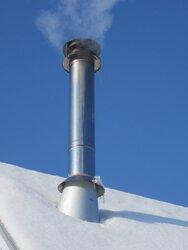Hi folks,
I'm sure this has been brought up many times, although it's my understanding that there are variables for different situations. This is the first winter burn in my new home. I have a storey and a half, with 12/12 pitch. My stove is a corner unit on the main level. I have approximately 12-13' of exposed Selkirk outside and roughly the same for interior stove pipe. there is a 45º elbow at my ceiling that is about 12". My stove is an Energy Pacific Alderlea T5. I have been only doing occasional burns, as a secondary heat source in the very cold months. I'm burning 75% birch and 25% maple. Not the most practical firewood, I know, but we moved in 2 months ago and I was in a pinch. This morning I noticed a golden brown ice formation at the base of the Selkirk on my roof, along with 12' frozen drips of the same colour. In some parts of the base there were dark brown accumulations. Being a newb, I'm not sure if this is normal or a cause for concern. Can anyone help me out with this? Thanks in advance.
I'm sure this has been brought up many times, although it's my understanding that there are variables for different situations. This is the first winter burn in my new home. I have a storey and a half, with 12/12 pitch. My stove is a corner unit on the main level. I have approximately 12-13' of exposed Selkirk outside and roughly the same for interior stove pipe. there is a 45º elbow at my ceiling that is about 12". My stove is an Energy Pacific Alderlea T5. I have been only doing occasional burns, as a secondary heat source in the very cold months. I'm burning 75% birch and 25% maple. Not the most practical firewood, I know, but we moved in 2 months ago and I was in a pinch. This morning I noticed a golden brown ice formation at the base of the Selkirk on my roof, along with 12' frozen drips of the same colour. In some parts of the base there were dark brown accumulations. Being a newb, I'm not sure if this is normal or a cause for concern. Can anyone help me out with this? Thanks in advance.


